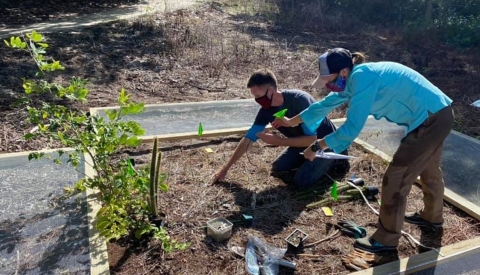It sounds like a Shakespearean play: Chrysopsis and Harrisia. Instead, it’s the names of two federally endangered plants on the road to recovery.
A bevy of nonprofit and government agencies, including the North Florida Coastal Program, have banded together to propagate and repopulate the Florida golden aster (Chrysopsis floridana) and the Aboriginal prickly apple (Harrisia aboriginum) in Manatee County.
The Florida golden aster (aster) was federally listed as an endangered species in 1986 as populations, found mostly on private land, dwindled due to urban development. Its habitat includes open areas in coastal dunes or inland pine scrub forests in the Tampa Bay area. Luckily, the aster propagates readily. New populations were created on public lands which are actively managed with prescribed fire and the removal of adjoining vegetation.
Bok Tower Gardens, near Lake Wales, has grown hundreds of asters that are then placed at Perico Preserve which is managed by Manatee County. The nature preserve and bird sanctuary was once farmland, but has been restored as coastal scrub habitat. Volunteers and staff from Manatee County and Bok Tower planted asters the past two summers at Perico.
The Aboriginal prickly apple (apple) was listed as endangered in 2013. It is a columnar cactus that sprawls along the ground. Its habitat consists of shell mounds, maritime hammocks, and the coastal grasslands of Southwest Florida. These areas are usually the highest local elevations and, therefore, were the first to be developed, leaving behind only isolated patches of suitable habitat. The apple was discovered in 1920 in what is now Terra Ceia Preserve State Park in northern Manatee County. It is believed extinct in the county.
The apple is proving more challenging than the aster. Yet it offers an opportunity to test different methods of propagation. Staff from the Marie Selby Botanical Gardens carefully harvested seeds from wild populations and grew them out in greenhouses. The apple grows slowly, though, reaching a foot in height in five years.
The botanical gardeners planted young apple plants at Emerson Point Preserve, adjacent to Terra Ceia. Different sites within the Preserve were selected based on varying levels of sunlight (full sun, partial sun, shade). The plants were also different ages – less than a year, more than a year, more than five years old – to determine which stands a better chance at survival. Half of all plants were protected with an “herbivory cage” to protect them from rabbits and gopher tortoises.
The botanical garden and Manatee County will continue monitoring the new apple and aster populations. The North Florida Coastal Program will continue funding the projects to apply lessons learned, as well as to introduce two more populations.




